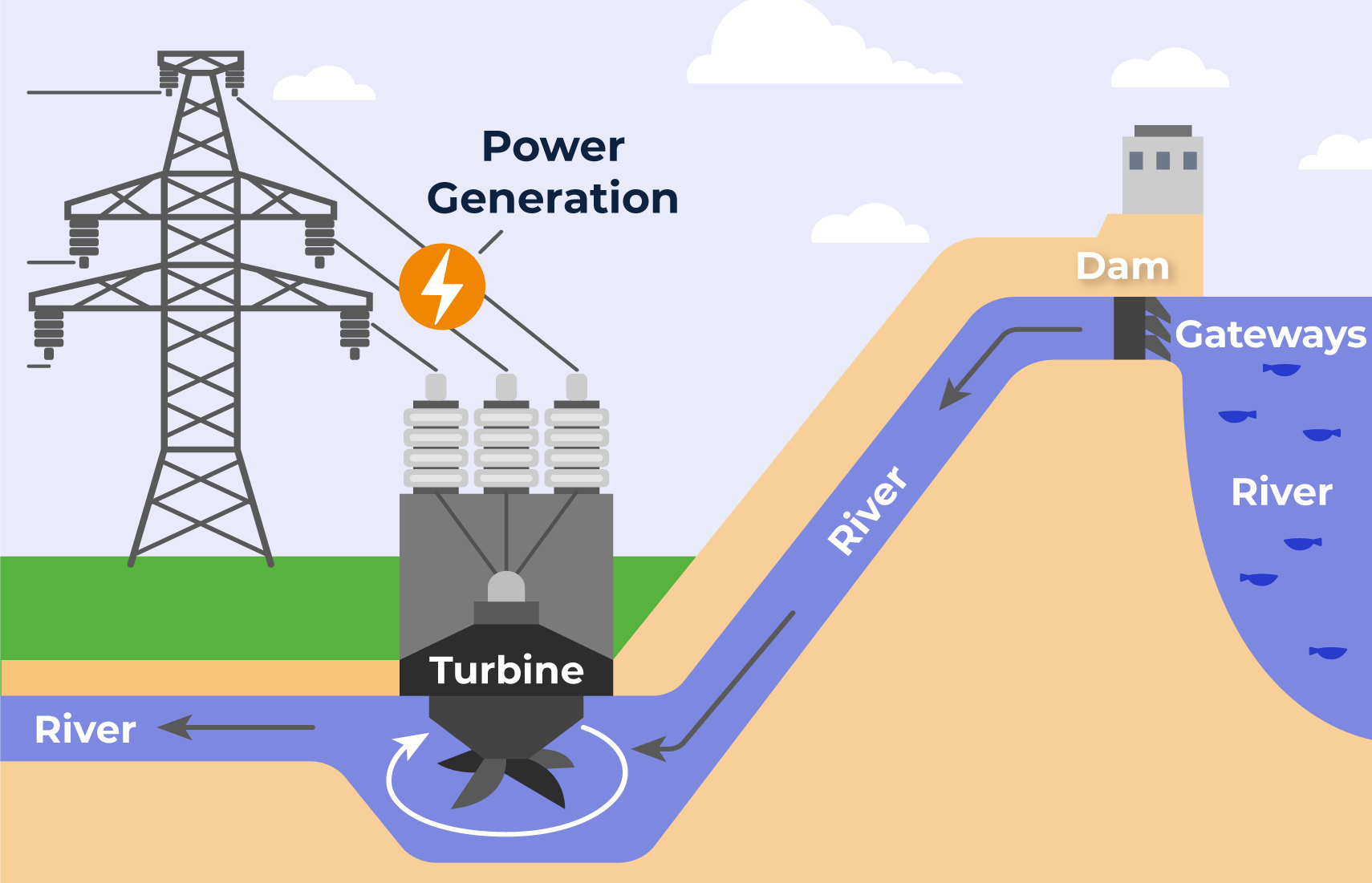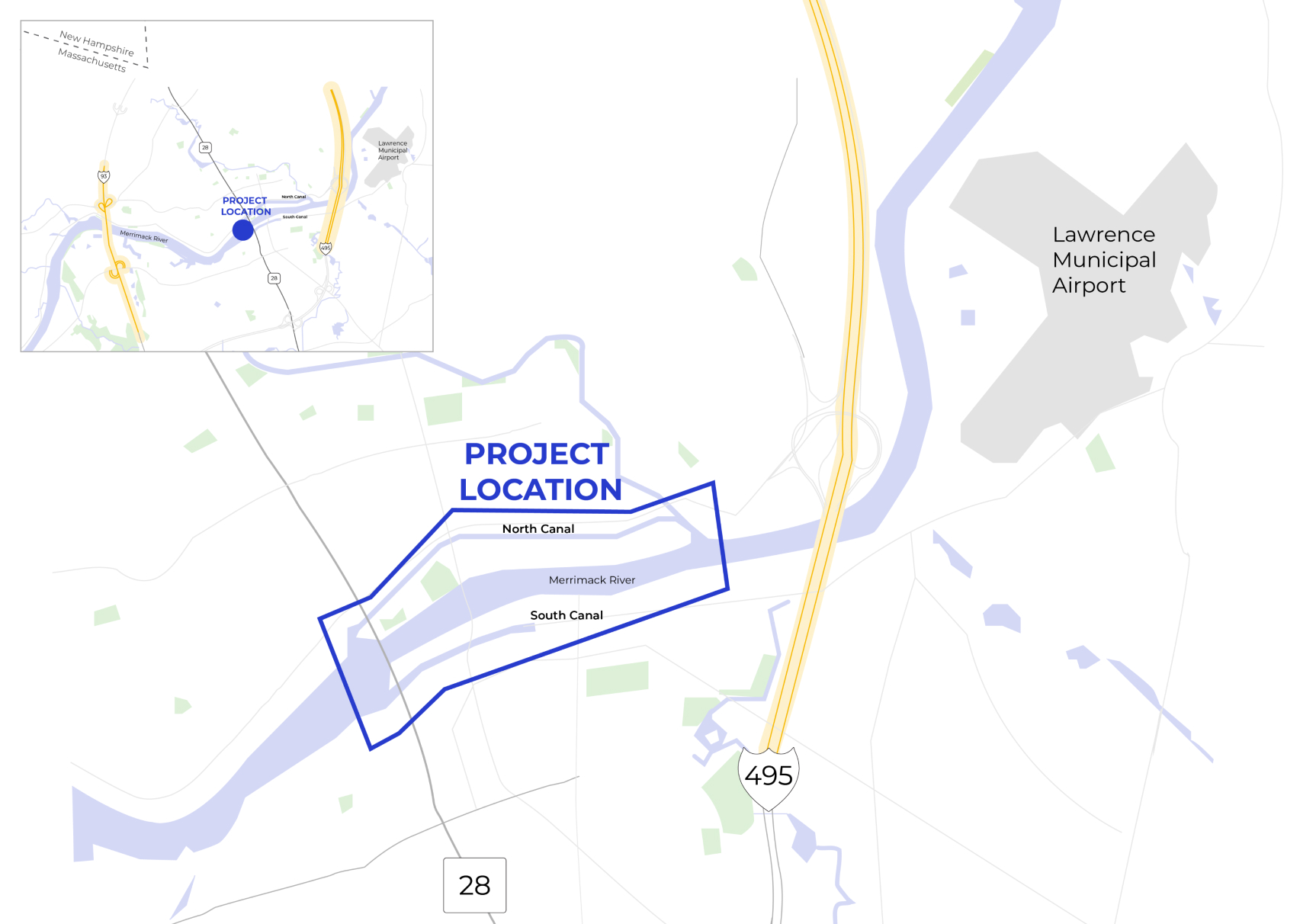Overview Preparations for relicensing
Essex Company, LLC (Essex) a subsidiary of Patriot Hydro, LLC owns and operates the Lawrence Hydroelectric project (No. P-2800) (the Project), which is licensed by the Federal Energy Regulatory Commission (FERC). The current operating license for the Lawrence Project was issued on December 4, 1978 and expires on November 30, 2028. Essex will file its application with FERC for a new license for continued project operation no later than November 30, 2026. As part of the relicensing process, Essex will be conducting a series of resource studies to assist FERC with the preparation of environmental review documentation and conditions for a new operating license.
Project Location Merrimack River
The Project is located on the Merrimack River in the City of Lawrence, Essex County, Massachusetts, with a 655-acre impoundment.
Project Components
Click or tap the cards below to learn about each of the project components.
-
Essex Dam
Essex Dam
The Essex Dam, also known as the Great Stone Dam, was designed and constructed on the Merrimack River between 1845 and 1848 at Bodwell's Falls. At the time, the site was built across a 750-foot portion of the river, where the banks were high enough to accommodate the construction of mills along the Merrimack, along with canals for power and diversion of excess water.
-
Impoundment
Impoundment
The Project operates in a run-of-river mode and creates a 655-acre impoundment upstream of the Essex Dam. The impoundment provides fish and wildlife habitat, serves as a recreation area for the community, and is a source for the municipal water supply.
-
Canal System
Canal System
The project features two canals on the North and South sides of the Merrimack River. The South Canal is approximately 35 feet wide and 10 feet deep, originating at the dam and running parallel to the river for approximately 2,750 feet. The North Canal is approximately 95 feet wide and 15 feet deep, originating at the dam and running parallel to river for approximately 5,300 feet before discharging near the confluence of the Spicket and Merrimack rivers.
-
Intake
Intake
The Project operates as run-of-river using an automatic pond level control system, which matches the Project's outflow to inflow while maintaining the reservoir water surface elevation at the crest of the dam. Flow into the two canals is controlled by entrance gates.
-
Powerhouse
Powerhouse
The powerhouse is located on the Merrimack River near the South Canal entrance and contains two 8.4 megawatt (MW) turbines and generators. A megawatt is the standard term of measurement for bulk electricity. One megawatt is 1 million watts. One million watts delivered continuously 24 hours a day for a year (8,760 hours) is capable of providing power for approximately 800 homes each year.
-
Fish Passage
Fish Passage
Fish passage refers to the ability of fish or other aquatic species to move through an aquatic system as part of a complete life cycle. Fish passage infrastructure provides open aquatic travel routes free of blockage or fragmentation associated with dams, culverts, or other diversions that can otherwise separate fish from breeding grounds or food sources. The Project has multiple fish passage facilities, including a fish elevator at the dam, a downstream fish bypass, and an eel ladder.
Hydropower 101

Hydropower, or waterpower, is the method of capturing dynamic energy created by running water for conversion to electricity. Hydropower was introduced by ancient Greek and Chinese civilizations through waterwheels and mills that helped power basic machinery.
Massachusetts became a world center of hydropower innovation in the 1840s following invention of the modern water turbine in Lowell on the Merrimack River. This legacy lives on today through the numerous dams, canals, and hydroelectric facilities on the Merrimack River.
Hydroelectric turbines transform the energy of flowing water into electrical energy by spinning the turbine blades, that in turn spin a generator which produces energy. The captured energy is directed through electrical transformers and into the power grid for human use.
Water turbines are a clean, renewable source of power production since they only require flowing water. Modern turbine operations are highly efficient (+/-95%) and can serve for decades after construction.
Process FERC Relicensing Process
Hydropower in America is overseen by the Federal Energy Regulatory Commission (FERC), an independent federal agency that authorizes the construction and operation of the nation's hydroelectric projects. FERC enforces the conditions of hydropower licenses while conducting ongoing project safety and environmental inspections.
A hydropower license authorizes the construction, operation and maintenance of a hydropower project for a term of 30 to 50 years. At least 5 years before an existing license expires, the project licensee must initiate FERC's relicensing process.
All license and relicense applications must contain information FERC needs to evaluate project effects and prepare environmental documents required by the National Environmental Policy Act (NEPA) and its regulations. All applications include detailed descriptions of the project facilities, operation, proposed changes, description of existing environmental, cultural, and historic resources, effects of the proposed project on these resources and the community(ies) in which the project is located, and proposed mitigation measures.
The Commission's Licensing Process
One- to Two-Year Pre-Filing Phase
- Identifies and obtains necessary information from an applicant's initial proposal, including feedback from public stakeholders
- Develops a scientifically supported study plan that characterizes the project's potential effects on resources such as recreation and water quality, with results used to develop the license application
- Engages the public by way of scoping meetings and a project site visit
FERC Review Period
- Reviews project benefits and effects
- Seeks public input, including feedback from the community, nongovernmental organizations (NGO), Indian tribes, and local, state, and federal resource agencies
- Further identifies environmental issues and determines what/if additional studies are needed to better understand key issues
FERC Post-Filing Environmental Analysis
- Performed after all necessary information gathering is completed
Additional Public Engagement
- Performed after the license application is accepted as complete, including new additional input from members of the public, NGOs, tribes, and government agencies
View Key Dates
In advance of preparing environmental documents required by NEPA, FERC uses comments and environmental documents to determine whether issuing a license for a project is appropriate and, if so, what environmental measures and other operating conditions to include in the license.
Documents and Resources
Visit our Resources page for Frequently Asked Questions & Project Documents and Resources.

